Hillside (Caleb Valentine House and Valentine-Pollitz Farm)
36-60 Main Street, Roslyn
Project Files
- 1859-Roslyn-Map-H.F.-Walling.pptx
- 1870-Pictorial-Map-of-Village-of-Roslyn-The-Nelson-Studio-Circa-1960.pdf
- Map-of-Roslyn-Beers-Comstock-Cline-1873.pdf
- Map-of-the-Village-of-Roslyn-1906.pdf
- Map-of-the-Village-of-RoslynRoslyn-Estates-and-Bulls-Head-E.-Belcher-Hyde-1914.pdf
- 1932-Street-Road-Property-Ownership-Map-Roslyn-Roslyn-Harbor-Glenwood-Landing-Greenvale-East-Hills-Roslyn-Heights.pdf
- National-Register-of-Historic-Places-Roslyn-Village-October-2-1986.pdf
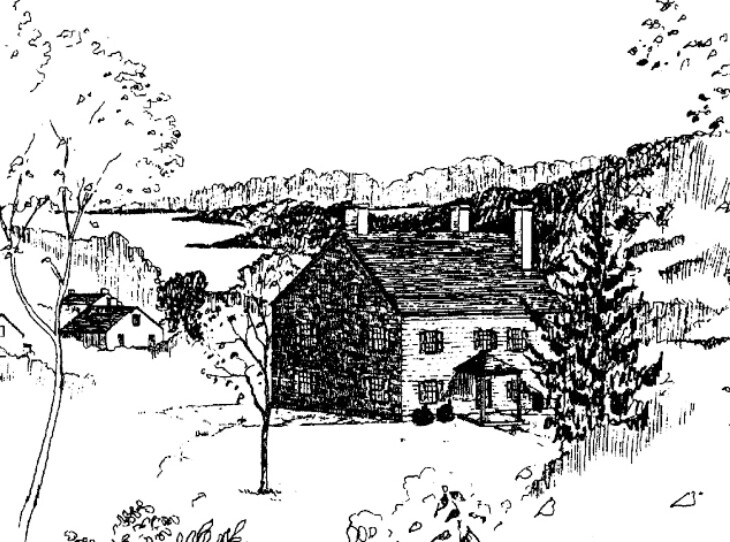
Adapted from the 1978 Tour Guide Book (P11).
This account provides the opportunity to insert the Caleb Valentine House into the historical record. The land on which the two Glen Avenue houses stand, high above the rooftops of the houses on Main Street, has a long and rich history that relates closely to the Grist Mill, the paper mill, and the houses on the west side of Main Street from No. 110 north to the George Allan house at 36 Main Street.
According to Francis Skillman, Caleb Valentine built a house on the west side of Main Street around 1800-1810. Caleb Valentine, born in 1767, was the brother of the William Valentine for whom the William M. Valentine House (former Roslyn Village Hall) was built around 1800. According to recurring local tradition, mentioned by Benjamin Tredwell Onderdonk, Francis Skillman, and the Roslyn News in the 1880's, Caleb Valentine's house stood below the two houses shown on the tour. It burned down in a spectacular blaze early in February 1887.
The likelihood is that Caleb Valentine's house (which is known to have been three stories high and "forty feet square" according to an advertisement in the Roslyn Plaindealer for July 11, 1851) was a building of comparable quality to the William Valentine house, and it may have been one of the group of local early Federal houses (including the William M. Valentine house, the Anderis Onderdonk House, the Valentine-Robbins house, and possibly the Robbins-Skillman house (Blue Spruce Inn) tentatively attributed to a single unidentified builder.
It is not quite clear how Caleb Valentine assembled his property, though he did purchase tracts of land in this vicinity from Hendrick Onderdonk, John M. Smith and John H. Williams, in 1801, 1812 and 1815. Francis Skillman says Valentine spent around $5000.00 in grading his site—a princely sum which would be worth more than ten times as much today. Valentine's purchase from John M. Smith included a grist mill—perhaps the Robeson-Williams mill, whose title has a gap between 1801 and 1828. However, the mill ledgers from 1803-1832 survive when the mill was operated and presumably owned by Hoogland, Coles and Underhill. There was another grist mill in the Village, somehere in today's park, which was mentioned by Benjamin Trewell Onderdonk in his 1851 letter to Eliza Leggett. This second mill may have been the one operated by Caleb Valentine.
Another local tradition recorded by Francis Skillman is that Caleb Valentine built a "tenant house" for his millwright. Skillman notes that the tenant house was "now" owned by George Allen, in which case it would probably be the Allen house at 36 Main Street, recently damaged by fire and now being restored by Dr. and Mrs. Roger G. Gerry.
Skillman, whose descriptions of local traditions still remembered by Roslynians in the 19th century usually turn out to be true, wrote that John Willis later lived in Caleb Valentine's house, which, if true, strengthens the case for its having been just south of No. 36 Main Street. The exact location of the Caleb Valentine house has not been determined. The Beers-Comstock Atlas of 1873 shows a hillside house belonging to O. W. Pollitz between and behind Nos. 36 and 60 Main Street. The Walling Map of 1859 indicates it in a slightly different place.
There exists, today, a stone stairway on the west side of Main Street that leads to a plateau supported by a stone retaining wall about 150 feet long. This is apparently the site of the house shown as O.W. Pollitz on the 1873 Atlas; and it may well be the site of the Caleb Valentine house.
Benjamin Allen was the next known owner of the Caleb Valentine property on Main Street. Tantalizingly, neither Allen's deed of purchase for this site, nor for the Robeson-Williams grist mill, which he owned from an unknown date after 1801 through 1828, has been discovered. It is just possible that the deeds are one and the same, and that Caleb Valentine did in fact own the Robeson-Williams grist mill for a time.
At any rate, on November 15, 1828, Allen sold half-interest in the grist mill, together with the Caleb Valentine house and lands, to John Willis (Queens Co., Liber X of Deeds, pgs. 425 and 428), who was shortly to become the developer of Main Street's late-Federal period west side. In 1835 Willis, who lived in the Caleb Valentine house, began to sell off Main Street building lots south of his dwelling house to James Smith, Epenetus Oakley, John Mott, Moses Rogers and probably others.
In 1839 he sold the Caleb Valentine house to John Sampson (Queens Co., Liber ZZ of Deeds, pg. 356, 5/1/1839). Augustus William Leggett*—William Cullen Bryant's associate on the Evening Post, co-founder of the Roslyn Plaindealer, and Eliza Leggett's husband— purchased the Valentine house from Sampson in 1841 (Queens Co., Liber 98 of Deeds, pg. 378) and it presumably was his residence until he sold it to Sherman Stevens of Pontiac, Michigan, in 1852 (Queens Co., Liber 98 of Deeds, pg. 378, 5/111852). Leggett's name for the house was "Hillside". The Leggetts had moved to Michigan after the sale of the Plaindealer in 1852.
An advertisement in the Plaindealer July 11,1851, mentions the existence of "two good tenant houses" on the "Hillside" property. Presumably one of them is the house at 25 Glen Avenue. Four years later Stevens sold his land to Mary Margaret Pollitz, wife of Otto William Pollitz, of Brooklyn (Queens Co., Liber 156 of Deeds, pg. 72,5/1 /1856). A few months later Mrs. Pollitz added an adjacent tract purchased from Henry Western Eastman (Queens Co., Liber 156 of Deeds, pg. 70, 11/3/1856) and the "farm" thus assembled was 70 acres of land that ran behind Main Street. The tract had a frontage of about 120 feet on Main Street in front of the Caleb Valentine House, but the lane now named Glen Avenue afforded the house an approach that could be used by horses and wheeled traffic.
John Codman Pollitz, a member of the family, was active in fund raising for the original Trinity Episcopal Church (for which a cornerstone had been laid in 1835 but which remained unbuilt until 1862). Pollitz, who enlisted in the Union Army just before the Civil War, presented his accumulated Army pay to Trinity's congregation as a contribution for the purchase of a bell for the new church. Ironically, Pollitz died at New Bern, North Carolina before the end of the war and according to tradition his funeral was the first occasion on which the bell was rung (TG 1969-1970).
FOOTNOTE: Augustus William Leggett probably was the individual who named Roslyn in 1844. It has long been known that a committee which included William Cullen Bryant, Parke Goodwin, Augustus William Leggett and others met to select a new name for the Village of Hempstead Harbor. According to a letter to the Roslyn News by M. A. Leggett, Augustus William Leggett's son, dated March 1, 1920, this meeting was held at his father's house and he, as a small boy, was present. He specifically states that it was "Augustus William Leggett who suggested the name." I know of no other account in the many descriptions of this renaming procedure in which the suggestion of the name "Roslyn" is attributed to a single individual.
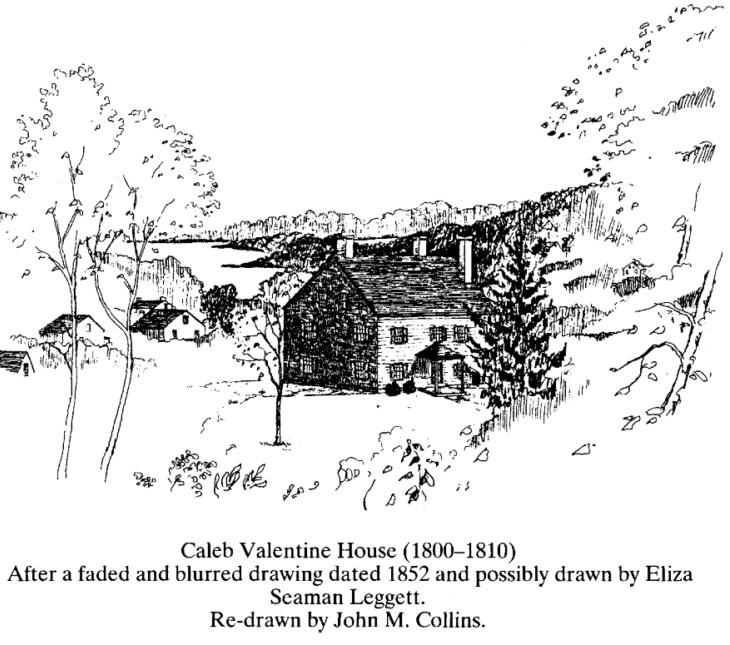
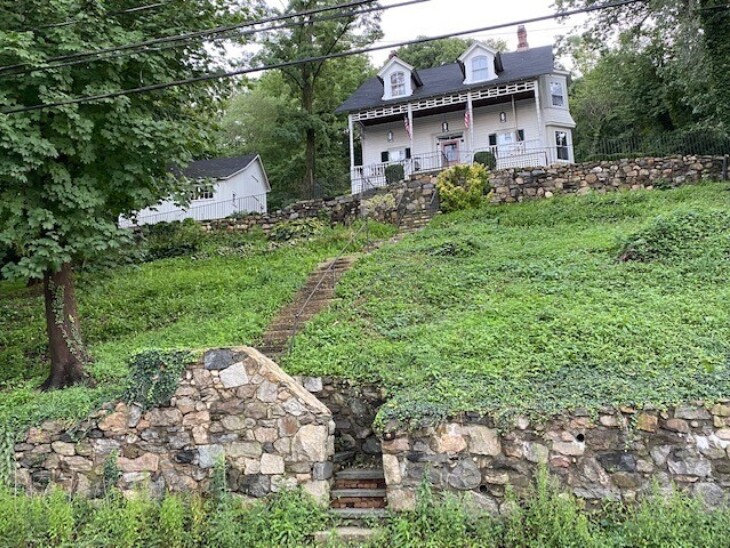
The stone stairway on the west side of Main Street that leads to a plateau supported by a stone retaining wall about 150 feet long. This is apparently the site of the house shown as O.W. Pollitz on the 1873 Atlas; and it may well be the site of the Caleb Valentine house.
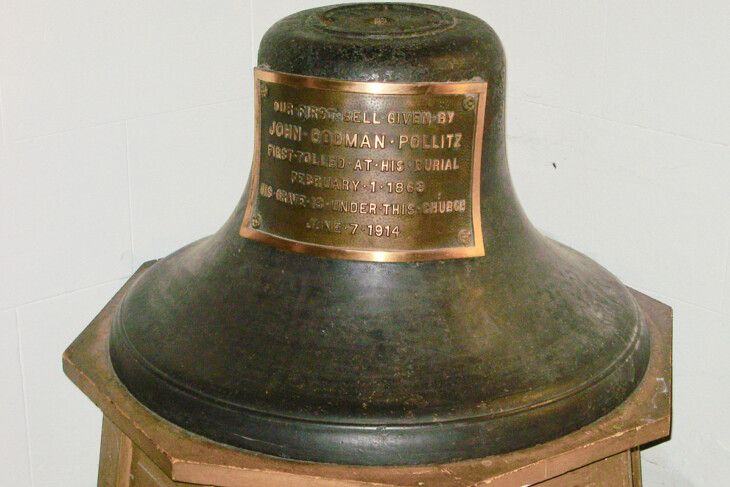
The original bell of the 1862 Trinity Episcopal Church was donated by John Godman Pollitz, who was raised in his parent's home at Hillside.
Politz saved his pay as a Union soldier for its purchase. At the age of 19 years in 1863, Pollitz died while serving in the Army. The bell tolled for the first time at his funeral.
The bell is inscribed:
"Our first bell given by John Codman Pollitz. First tolled at his burial, Febrauary 1, 1863. His grave is under this church. June 7, 1914"
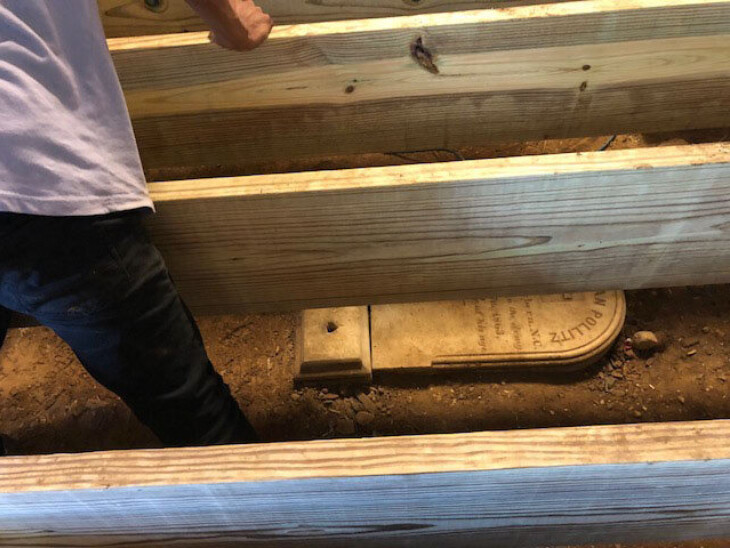
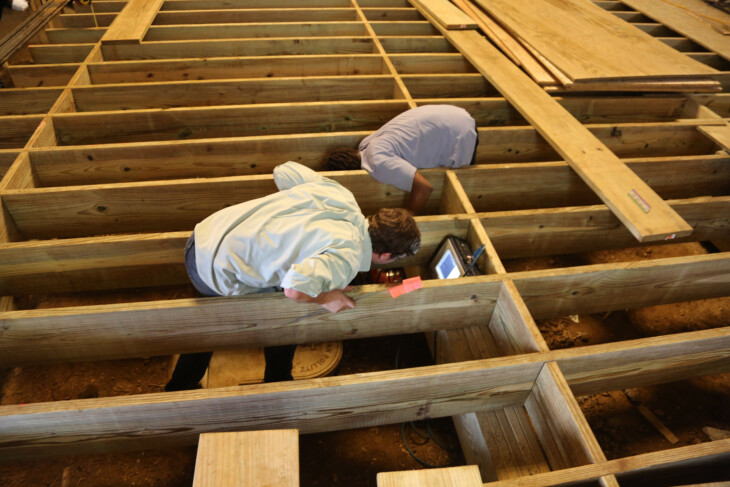
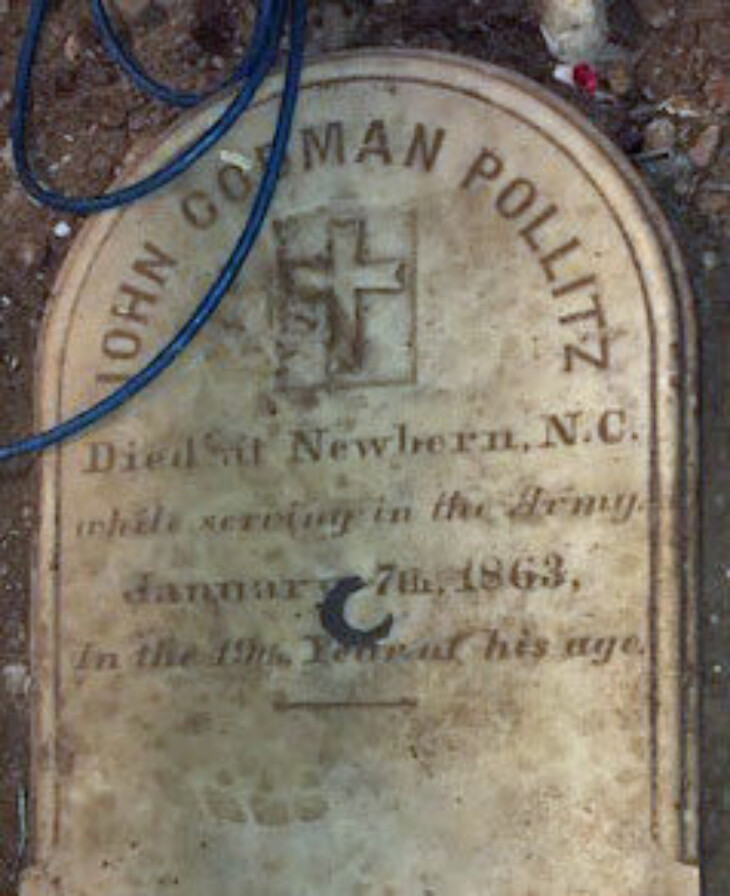
On July 24, 2018, construction workers resting the church's floor discovered the gravesite of John Codman Pollitz. His headstone reads:
John Codman Pollitz
Died at Newbern, N.C.
while serving in the Army
January 7th 1863,
In the 19th Year of his age.
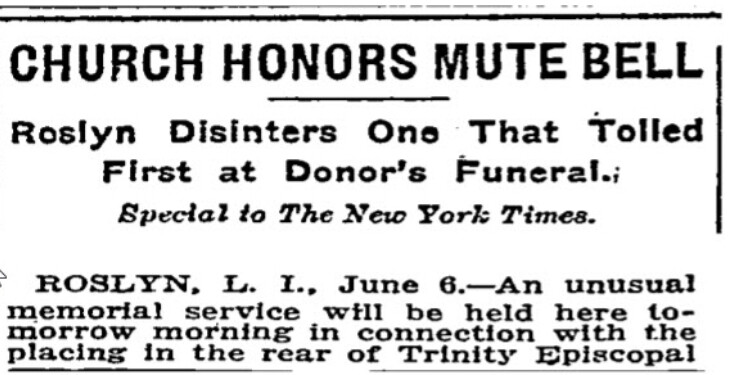
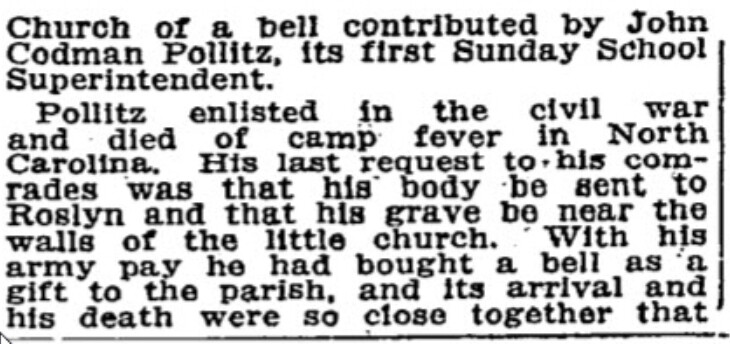
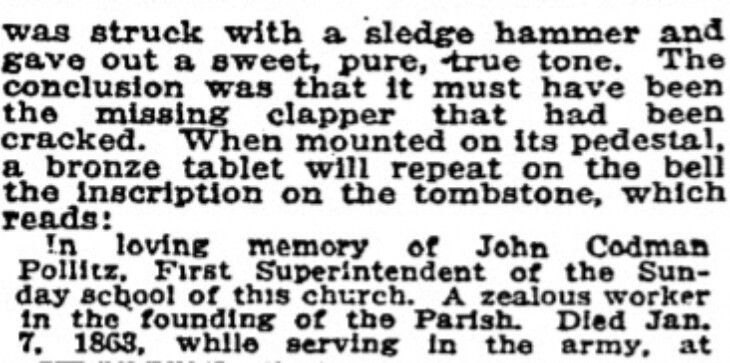
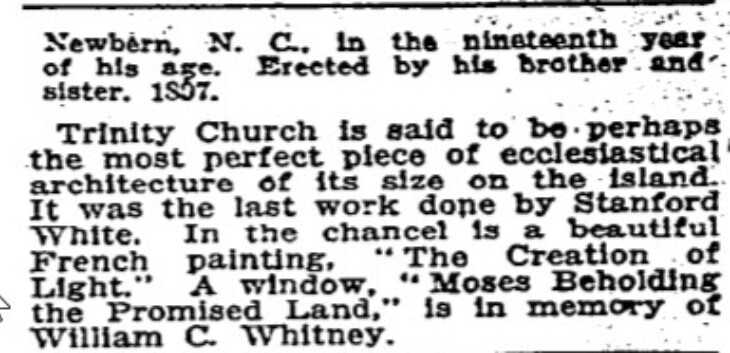
The New York Times, June 7, 1914
0 Comments